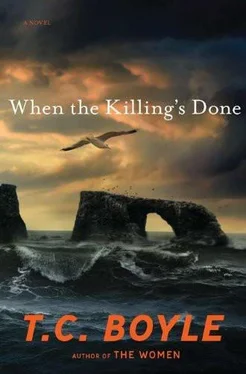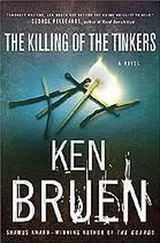She has them now, and never mind that privately she’d like to see all free-ranging cats exterminated in fact and by law, because she’s ascending into her rhythm, the Latin nomenclature rolling off her tongue as if she were a priest in training, every fact and figure at her command, no need at all to glance down at the notes she’s printed in 22-point type so she can dispense with her glasses and give them the full effect of her eyes. As the images click behind her, she presents a quick overview of island biogeography, of how isolated species evolve to fill niches in the ecosystem and of how that balance, unique to each island throughout the world, can be upset by the introduction of mainland species. She talks about the dodo, perhaps the poster animal for island extinctions, a pigeon-like bird that found its way to an isle in the Indian ocean and subsequently evolved, in the absence of predators, into the waddling big-bottomed flightless bird made infamous by its very helplessness.
“The dodo was naive,” she says, giving them a hard, no-nonsense look, because this is the reality, this is what it comes down to — the permanent loss of an irreplaceable species — and there’s nothing funny or even remotely ironic about that. “That is, it had had fear and suspicion bred out of it, and so waddled right up to the first seaman to land on the island of Mauritius, who plucked and roasted it, then introduced pigs and rats, which fed avidly on the eggs of this ground-nester. Flight is expensive,” she goes on, “in light of caloric resources expended, and so too is tree-nesting. Why fly, why nest in a tree, if you’ve evolved in a place where there are no predators? The answer for the dodo — the result, that is — as every schoolchild knows, was extinction.”
The audience has settled in, the initial rustling, nose-blowing and fist-suppressed hacking fading away into what she’d like to construe as engaged silence rather than a collective stupor. But no, they are engaged: she can feel them, alert and awake and alive to the argument to come (key words: rats and poison ) and the bloodletting of the Q&A that will follow. All right. Time to bring it on. She clicks the mouse and the next image to infest the screen behind her is of those very rats, eyes gleaming demonically in the sudden illumination of the photographer’s flash, as they rifle the nests of gulls and murrelets, their paws and snouts wet with smears of yolk, albumin and chalaza.
“Rats,” she announces, letting the final s sibilate on her lips till it buzzes back to her through the speakers, “are responsible for sixty percent of all island extinctions in the world today.” A pause for effect. “And rats are killing off the ground-nesting birds of Anacapa Island.” Pause the second, this time accompanied by the steeliest squint she can manage, considering that she can barely see the audience. “Which is why I am here tonight to tell you that we must act and act now if we want to save these endemic creatures from the same fate that met the dodo, the Rodrigues solitaire, the Stephens Island wren, the Culebra Island giant anole and dozens — hundreds, thousands —of others.”
And now the rustling, the creaking of the chairs and the whisper of voices, excitement flashing through the crowd like an electrical charge: this is what they’ve come for. And it’s what she’s come for too, the moment of truth. She straightens up, squares her shoulders. She has them in her power and now is the time to lean into the microphone, hold them with that squint, and say: “Which is why we have, after long deliberation and with the full backing of the National Park Service’s biologists and the California Department of Fish and Game as well as the scientific community at large, decided to go to the air with the control agent brodifacoum to suppress the invasive rodent population, which, incidentally, is threatening the native deer mice in addition to the murrelet, the pigeon guillemot, the western gull and the cormorant.” She clicks the mouse to display a close-up of a tiny Xantus’s murrelet with its black head and mask over a white throat and underbelly, looking stricken as the snaking dark form of a rat gnaws the egg out from under it. “And let me assure you that this agent is quick-acting and humane, and that if we were presented with any other alternative we would gladly have taken it, but given the urgency of the situation and our confidence in the method of control, we have, have. .”
The crowd has fallen silent. They’ve become aware of a presence she’s just now perceived at the periphery of her vision, the figure of a man risen from a seat at the far end of the front row, his hair in rusty dreadlocks, his head bowed, muscles rigid, his jaw clamped in fury. She knows him. Of course she does. And of course he’s here and of course he’s interrupting her and behaving like a brownshirt, like a, a—
“Bull,” he pronounces, and his voice echoes from one end of the auditorium to the other. “Propaganda and doublespeak.” He swings round on the audience suddenly, his arms raised like a prophet’s. “Did we come here to listen to the party line like a bunch of drones under some communistic dictatorship, or is this a public meeting? Do we want our questions answered? Our point of view represented? Or is this show for mutes only?”
A groundswell of applause, a scattering of voices, male and female alike, calling out encouragement and then a chant starting like the rumor of a distant wind and blowing stronger with each repetition, “Q and A, Q and A, Q and A!”
And now she’s raising both her hands, palms out, in a gesture for silence, patience, simple common courtesy, and a rumble of voices arises in support. “Sit down,” someone calls from the darkness. “Button it.”
“All right,” she hears herself say, her amplified voice coming at them like the voice of a god, stentorian, omnipotent — she has the microphone and they don’t—“we’ll address all your concerns and take your comments in a minute. As for you, Mr. LaJoy”—he’s still standing there, his arms crossed in defiance—“your opposition to our goals is well documented, and you will have your chance to comment, but I’m going to have to ask you to sit and wait your turn.” And then she adds, superfluously, “All things in time.”
The applause now is definitely on her side, on the side of civility and restraint, and it continues until Dave LaJoy sinks back into his seat and she’s had a chance to take a sip of water from the glass Frieda has left for her on the ledge beneath the lectern, and is her hand shaking as she lifts it to her lips? No. It’s not. It’s definitely not. Determined not to let them ruffle her, she sets the glass firmly down and picks up where she’s left off, describing — and yes, minimizing — the effects of the control agent and once again bringing home the point, in ringing terms, that there is absolutely no alternative to the proposed action, even as the final image, of a murrelet tending its nestlings against a soft-focus background of clinging plants and dark volcanic rock, crowds the screen behind her. She takes the applause graciously, bows her head and waits till Frieda has mounted the stage in her rangy unhipped slump-shouldered stride and thrust herself into the spotlight. “ Now ,” Frieda projects into the microphone on an admonitory blast of static, “ now Dr. Takesue will take your questions. In turn. And one at a time, please .” She waits a moment, as if daring anyone to defy her, shields her eyes against the glare, and calls out into the void, “Up with the house lights, Guillermo. We want to see just whom we’re addressing.”
Immediately, Dave LaJoy is on his feet, his hand rocketing in the air — and there she is, Anise Reed, seated beside him in her cyclone of hair, her eyes burning and her hands clenched in her lap. Alma, her glasses clamped firmly over the bridge of her nose now, ignores them and flags a woman ten rows back. Red-faced, with a corona of milk-white hair and a pair of rectangular wire-rimmed glasses that could have come from the same shop as Frieda’s, the woman unfolds herself from the chair and in a thin sweet aqueous voice asks, “What about the mice? Won’t the poison hurt them too?” then drops back into the chair and the anonymity of the crowd as if to stand for one second more under the public gaze would crush the breath out of her.
Читать дальше












